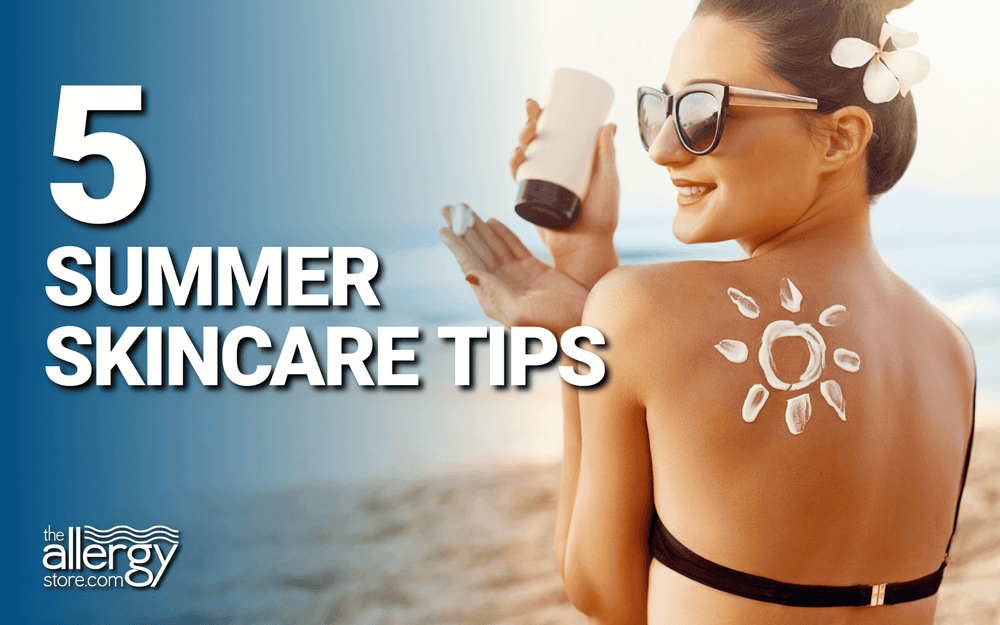
We know Spring just started but is time to start thinking about summer skincare.
Moisturize from the Inside Out to Prevent Dry Skin
If you ignored your skin over the winter, you are probably already dry. Your skin is supposed to be 64% water. Winter makes it tough to maintain that level of moisture.
Between the dry, heated air and the cooler temp’s dulling effect on your desire to drink, your skin cracks or flakes. Your skin can’t stay naturally moisturized when your body is dehydrated.
Mild dehydration is defined as a loss of 1% of your body water. You don’t even begin to feel thirsty until you’ve lost 1 to 2% of your body water. That means you must drink before you are thirsty. Don’t think that sip of rum by the pool is going to help. Alcohol is dehydrating, drink water.
Not only does drinking water moisturize from the inside out, but well-hydrated skin plumps up. This reduces the appearance of wrinkles and pores.
Exfoliate for Smoother Skin
Great looking skin starts with getting rid of the old and encouraging growth of the new. Exfoliate regularly to help keep clogged pores at bay. Remember, freshly exfoliated skin burns more easily, so use that sunscreen liberally.
Exfoliating is for more than just your face. Use scrubs on your body to stimulate circulation and new skin cell growth and remove those dry dead skin cells that look so dull. You can make scrubs at home with products found in every kitchen.
Choose Sunscreen Wisely – Then Use It!
While many use sunscreen every day of the year, it’s even more important during summertime. Days are longer, the sun is stronger, and we spend much more time outdoors. Choose your sunscreen wisely and read labels carefully.
Start by finding a product that is PABA free. This common sunscreen ingredient can cause painful reactions in many people.
Stay away from sunscreens with Vitamin A or Retinyl Palmitate. You might think that since vitamin A is good for the skin then it should great for sunscreen. Wrong! Researchers have discovered that vitamin A speeds the growth and size of tumors when applied to skin that is exposed to sunlight.
Pick a sunscreen that offers broad-spectrum protection. You want a sunscreen that is effective against both UVB (skin-burning) and UVA (skin-aging) rays.
UVA and UVB rays can also contribute to skin cancer, the most common cancer of all. If you see “broad spectrum” on a label, it’s a good thing.
Choose a sunscreen with an SPF rating of at least 30. The SPF number indicates the level of protection against UVB rays. Higher SPF numbers mean more protection, but the higher you go, the smaller the difference becomes.
No sunscreen is truly waterproof, even though that term appears on many product labels. If the front label says “water-resistant”, it must specify whether the protection lasts for 40 minutes or 80 minutes of swimming or sweating.
For the best protection, reapply sunscreen every 2 hours and even more often if you are swimming or sweating.
Many of our customers use Vanicream SunSport35 at the recommendation of their doctor. Dermatologists love Vanicream sunscreen because it doesn’t contain fragrance, masking fragrance, parabens, or formaldehyde. And don't forget your lips.
The EWG’s guide to sunscreens always rates it highly because it doesn’t contain a toxic mix of chemicals that does more harm than good. It also does not contain Vitamin A.
Moisturize Immediately After Bathing
When you get out of the bath or shower, avoid the temptation to rub with the towel. It might feel invigorating, but it damages your skin. Pat your skin until it is slightly damp. While the skin is damp, apply a generous portion of lotion or cream.
Only use products that are paraben-free and formaldehyde-free like Vanicream Skin Cream and Vanicream Lite Lotion. Read labels carefully and reapply moisturizer throughout the day.
Sun Allergy?
Many people experience a weird allergy every year upon their first few exposures to the sun. It’s almost like they are allergic to the sun. It’s called polymorphic light eruption or PLE. You might hear it called sun allergy, but it isn’t a true allergy. Initial exposure to sunlight causes an itchy red rash. This is not a sunburn.
Polymorphic light eruption may only happen when you are taking certain medications or eat trigger foods. More often, it only happens the first time your skin sees the sun. For most mild cases, no treatment is needed other than moisturizing and maybe an over the counter corticosteroid cream for the itching.
Factors such as family members who experience sun allergy or previous outbreaks of sun allergy are indicators that it can happen again. Whether you have sun allergy or not, it is a good idea to protect your skin when going out into the spring and summer sun.
Now that summertime is here, get outside and enjoy it. Blue skies and sunny days await you!
Wishing you the best of health
The Allergy Store
Summer Heat Tips | Stay Cool and Comfortable this Summer
Want to Know More?
By reducing your exposure to allergens, you may be able to reduce your need for medications and visits to the doctor. If you want more detailed information, click here to download your free copy of Cheryl's e-book" You Can Do It! Allergy Free Living”.

